29 June-30 July 2002
By Yves Van Roosbroeck (yvesvan
roosbroeck
pandora
be).
Nairobi
By Yves Van Roosbroeck (yvesvan
roosbroeck
pandora
be).
Nairobi
Bok takes his backpack from the conveyor belt and Mario and me are watching.
Minutes later I becomes clear to us. We will have to come back again
tomorrow, our luggage has not arrived. Then it also cannot be stolen
in Nairobbery is what we think optimistically!
We are in Nairobi, the capital of Kenya. According to books and
travel reports, the city is a dark robbers’ den. It is already dark
when we leave the airport building and a taxi takes us to our hotel.
It is a lousy guesthouse on the 8th floor of a big concrete building.
The eternal bustle of the metropolis and the noise of the cars keep us
awake all night long.
The next morning, we agree about one thing, we want to get out of Nairobi
as soon as possible to find some quieter and safer places. But firstly
we have to go back to the airport to collect our two missing backpacks.
Luckily, they have arrived! We can enter Nairobi for the second time…
Lake Naivasha
In the dusty village of Naivasha, we are pushed into a matatu with 21
people. We are sitting in the back. For outsiders: a matatu
is a minivan, the size of a van that holds 6 to 8 people in our country.
At the Fisherman’s Campsite, we exit the matatu through the window in the
back. By doing so, all the other passengers don’t have to evacuate
the van to let us out!
We rent a hut with a view on the lake for two days. There should
live hippo’s in the lake that come out at night to graze on the shore.
First seeing, then believing!
We take a walk to explore the surroundings of the lake and we meet
Thomas. He is a black Kenyan and the owner of a neighbouring hotel.
After we did some small talk, he asks us if we are interested to go watch
the final game of the World Cup 2002 in a private bar of a power company.
Surrounded by only black supporters, we watch the game on TV.
Germany is fighting against the much better team of Brazil. The black
supporters are not hiding anything, Brazil is their favourite! The
last-mentioned wins the Cup and the black people are satisfied.
Back at the lake, we wait for the hippo’s in the dark, weaponed with
our camera’s. But they don’t show up. When we are out of patience
and the thirst comes up, we enter the bar and try the local beer: Tusker!
Quite nice!
In our hut, a badly installed mosquito-net results in an uncomfortable
night and a constant fight with the net and the blankets.
We have breakfast at Thomas’ place between the chickens and the goats.
It looks as if he made his ‘hotel’ all by himself with things he found
somewhere. It looks old, but it has got something ‘genuine’.
Thomas used to be a chemist, just like I am, but now not any more.
Working with tourists raises more money to him these days in Kenya.
When he was still a chemist, he travelled to Europe for his work many times
because he was one of the few employees who had a travel-passport.
“I was in Iceland. It’s a very cold country!” Thomas knows
about the European culture and he knows how we think, that is his strength.
He knows we don’t like to bargain for everything and has fixed, but reasonable
prices. Thomas gains our trust immediately and will be our guide
for the coming days.
The interesting thing about Kenya and Tanzania is that the game-parks
are not surrounded by wires or fences and for that reason, it is possible
to encounter almost any animal at any place.
On the way to Crater Lake in Thomas rusty vehicle, we are lucky already!
There are impala’s and warthogs besides the road. Our first encounter
with the African wildlife during this holidays is amplified by some zebra’s
and vervet-monkeys.
The water of Crater Lake is emerald-green and there are some 1500 pink
flamingo’s in the lake. The circumference of the lake is about 2
kilometres. The inside of the crater wall is covered with acacia-trees
with Colobus-monkeys in them. Bok and Mario’s first photo-film is
finished quickly with all this beauty!

Crater Lake
On the way back, Thomas takes us to a much smaller lake, where we can
watch hippo’s. On the shore of the lake, a group of Masai-people
live there. The Masai are nomads, from whom the elderly refuse any
form of development. The people have always lived in harmony with
nature and their herds of sheep, goat and especially cows provide them
with all their needs. The herds are holy to them. The Masai
live especially in the south of Kenya and the north of Tanzania.
Big parts of their former habitat are now protected as natural reserves
by the government and the Masai are not allowed to live in these protected
area’s any more. The Masai-Mara National Park in Kenya and the adjacent
Serengeti National Park in Tanzania are now a forbidden zone for the Masai
and this causes a lot of problems and protest from the nomads. Now
they roam some private properties in the vicinity that are actually way
too small to fill their needs. Some of them yield to progress and
try to live from what’s much more important to the government: tourism.
They guide tourists or earn money by posing for pictures in their colourful
traditional clothes. The more conservative Masai are stubborn and
try to hold on to their traditions, but they are hindered by the government.
For instance, there is this tradition that a young Masai at the age of
14 undergoes the circumcision-ritual and after that, he is left alone in
the bushes. Only after he slaughtered a lion by his own hands, he
can return to the community, showing them the heart and the tail of the
lion as proof. Since lions are endangered and protected nowadays,
the slaughtering of the animals is forbidden and the tradition fades away.
To give the Masai some room for their traditions, the government allows
them to kill a dangerous or unwanted lion that occurs somewhere sometimes.
In this way, the traditions and wishes of the Masai can somehow stay alive.
Surrounded by hundreds of cows and goats, we watch the hippo’s from
the shore. Some young Masai approach us with some hesitation and
a little while later, they are close by. They look curious, but ask
or say nothing. One of them seems very interested in Bok’s camera
and tries to look through the lens while kneeling. Mario lets the
kid watch the hippo’s through his camera. The young generation of
Masai seems interested in modern technology and wants to know about that!
In the evening at the campsite, the hippo’s again don’t show up.
We have dinner at Thomas’ place with some others.
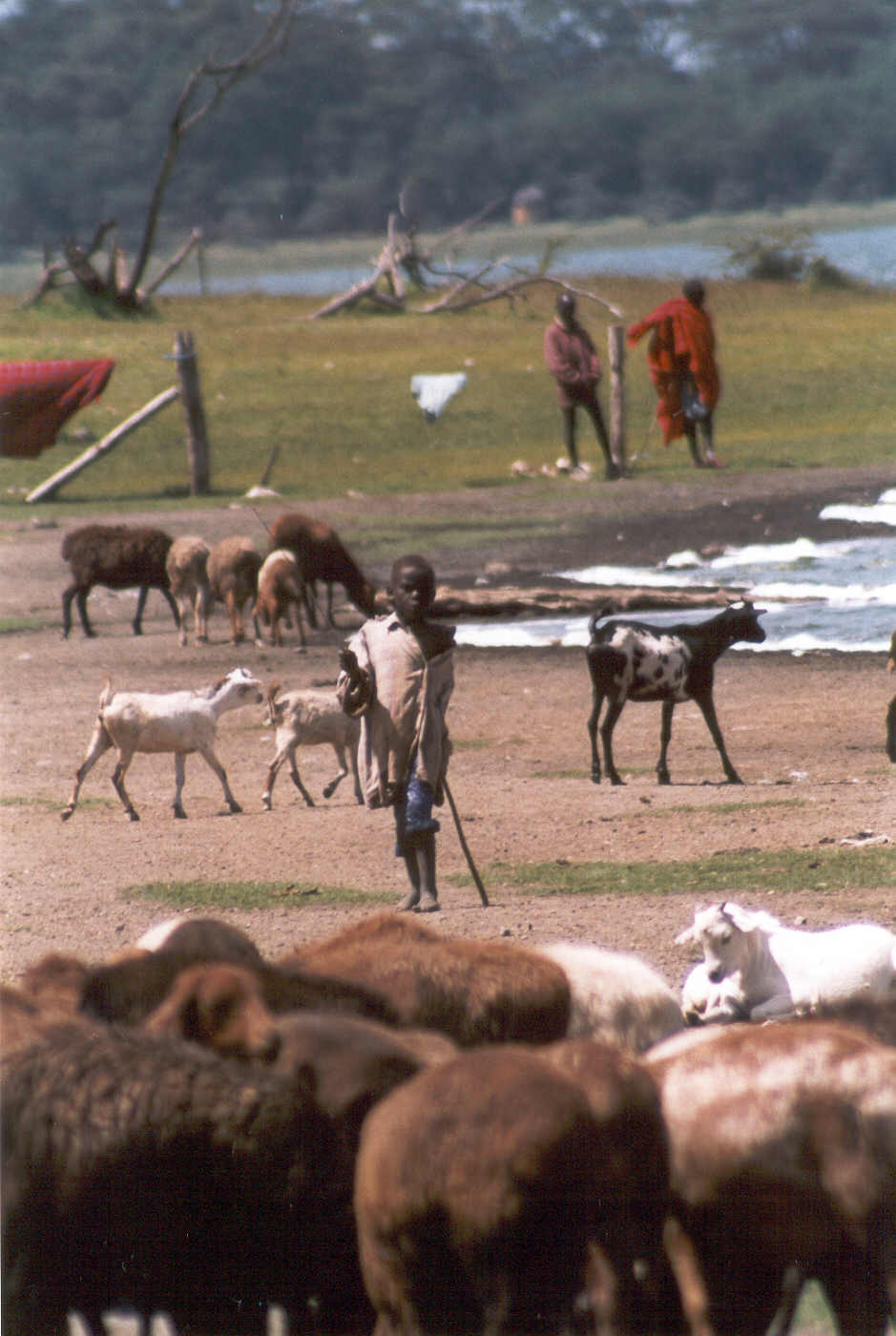
The Masai
Crescent Island
Crescent Island is, as the name already suggests, a half-moon-shaped
peninsula within the lake Naivasha. We can walk there freely between
giraffes, waterbucks, wildebeests, zebra’s, impala’s and pythons.
All these animals, with the exception of the pythons, are brought here
for the recordings of the movie “Out Of Africa” with Robert Redford and
Meryl Streep in the cast. The landing site where the actor had put
down his airplane is still here!
There are no dangerous animals here, we wouldn’t be able to walk here
safely if there were.
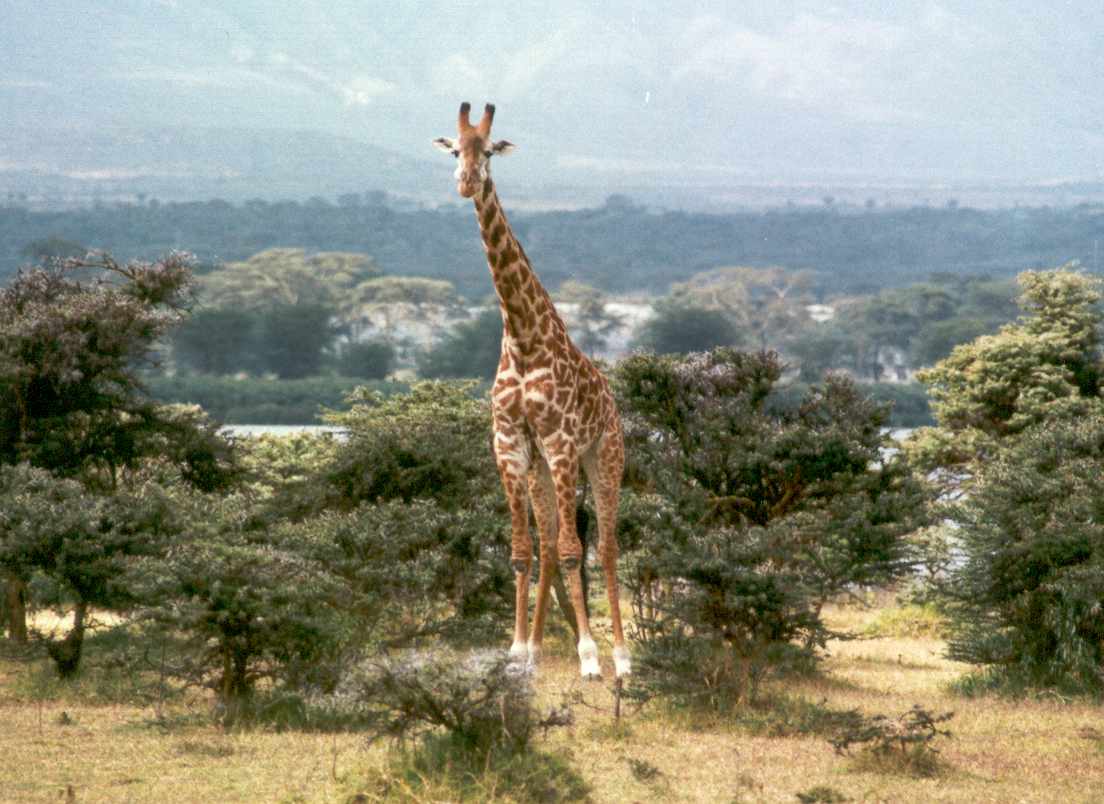
A giraffe on Crescent Island
In the Serengeti, the yearly wildebeest migration has begun. The
animals run to the north, towards Kenya, because it is much greener there
than in the drying Serengeti. Strangely enough, the wildebeests from
Crescent Island also show this behaviour of going northwards. If
I tell you that this peninsula is only 2 square kilometres big and therefore
it has no differences in climate, it seems totally meaningless to do so.
Nevertheless, Crescent Islands wildebeests run to the north from May to
November and south from December to April, as if they have a sensor that
tells them to do so! That is so strange!
Thomas takes us to the clean Silver Hotel in Naivasha. We change
some money in a bank and say goodbye to Thomas.
In our hotel, we want to make a wild guess and order matumbo for dinner,
without knowing what it is. I ask the waitress what it is and she
says: “Euhh…meat!”. According to Mario, it is kidneys in their own
juice and according to me, it is the skin of a hippo. Anyway, there
is a big chance that we ate some organs here. It doesn’t taste good
at all.
Tanzania
We leave Kenya already, after changing buses in Nairobi. In the
beautiful evening-colours, we ride through the savannah and the view is
magnificent. The primitive Masai-villages in the middle of the savannah
give us the impression that we travelled back in time. Some ostriches
are scattered throughout the landscape. Colourful nomads, surrounded
by their herds, roam the fields. The windows of our bus are like
TV-screens from National Geographic Television.
Right after we arrive in Arusha, all kinds of safari’s and trekkings
are thrown at us by all kinds of travel-agencies. Each of them is
the best and there are more than 200 of them. Tomorrow we will take
our time to choose a decent travel-agency to arrange our trek to the Kilimanjaro
and safari in the Serengeti.
The travel-agency Victoria Expeditions from our hotel Meru House Inn
seems to be the best choice to us, but we also take a look at African Adventures,
the company that our friends Theo and Katrien went with 3 years ago.
In the guest-book, I can find their 3 year old writings! After bargaining,
we choose Victoria Expeditions after all.
Kilimanjaro
In six days time, we will try to climb the Kilimanjaro, with its 5895
meters the highest mountain of Africa, to the top. We are a group
of 3 only and 4 porters, a cook and a guide will help us to try to bring
this undertaking to a good ending.
The climb starts at 1700 m above sea-level on a muddy trail through
the jungle. We climb today on the Machame-trail to 2700 m above sea-level
in the rain. There is the first camp. One of our porters falls
over a slippery tree-root with his basket full of pots and pans.
Mario sings “Ten small ’s”. A while later, our guide and the
porters are out of sight, we left them far behind.
After hiking for ten kilometres, we arrive at camp 1 and we can already
see the top of the Kili. Perhaps it would have been better if we
didn’t see that, because it seems so far away and completely out of reach.
In the morning, it is terribly cold and the first rays of sunshine
are like a god. Today, we will climb from 2700m to 3800m a.s.l.,
a good kilometre up, but there is still enough oxygen in the air and we
are in good shape. On the contrary, one of our porters isn’t that
well. Almost at camp 2, he is exhausted and sits besides the track
with his overload-backpack next to him. Our guide Arusha is angry
at him. The poor porter is almost crying. We propose to take
the heavy backpack ourselves for the last part of today’s hike, but Arusha
doesn’t want that. Is he afraid that his tip will be smaller at the
end of the trip, or is he trying to rescue his pride? With 2 big backpacks,
one on his back and the other one on his head, Arusha continues to walk,
followed by us.
Suddenly, egg yolks start to drop from the backpack, eggs must have
been broken. Still Arusha doesn’t allow us to give him a hand and
walks-on while cursing all the time. When we arrive at camp 2, our
poor porter gets another yell from our guide Arusha, while he throws his
anger at the porter.
As long as the sun is above the skyline, it is still pretty warm at
3800 m, but once the sun has set, it cools down pretty quickly. When
darkness has fallen, I watch the stars, they are much brighter here than
in Belgium. I can see the Scorpion, the Southern Cross, the Milky
Way. And look there, a falling star! Guess what my wish is!
The altitude is becoming sensible. When I get up, I have a severe
headache. Much worse than the hangover-headache I experience after
going-out on a Friday evening in Heist. The medication hardly does
any good.
Today is “acclimatising-day”. We climb on to 4600 m to subsequently
descend to 3900 m, where camp 3 is located. The top comes slightly
closer now, but is still far away. The sky is clear-blue and the
clouds are below us. The air-temperature is not that high, because
of the thin air, but the rays of the sun are becoming more powerful because
of the atmosphere getting thinner the higher we climb. The hats and
caps are put on, because anyone who gets a sunstroke now, must go down
without any excuse!
We ask our guide Arusha what matumbo is, the strange dish we ate in
Kenya. “Stomach”, says Arusha while laughing. We ate stomach
in Kenya, yuk!
The day after acclimatising, we climb on to the respectable height
of 4900 m, where camp 4 is. One day to adapt to the height wasn’t
enough, because the headache remains. The vegetation became scarce
and we passed the tree level long ago. At this altitude, the only
things that grow here are tiny dry flowers.
Breathing becomes more and more difficult and the sun is hard to stand.
At this altitude, the sun is both a blessing and a curse. If it is
not there, it is way too cold and we want the sun to shine. But if
it is there, the rays are so powerful that we wish it would disappear behind
a cloud. The summit is still a thousand meters above my head and
I already realise it will not be a joke to get up there!
At midnight, we commence the final climb to the summit of the Kilimanjaro.
The sky is full of stars. The Southern Cross, accompanied by the
Charcoal-hole is already setting. The Milky Way is sky-high and also
the Scorpion is a silent witness of our foolish nightly undertaking.
There is no moon.
We put our flashlights on our heads and the final ascend starts.
The interesting nightly sky causes me to watch up too much and don’t mind
the narrow trail below enough. I almost fall several times.
Soon enough, we are at 5000 m above sea level. A non-trained
person like I am doesn’t mean much at this altitude. The air is so
thin that I can’t think straight any more and every unexpected movement
takes my breath literally away. Is this sportive achievement good
for the body? Forget that! This is not healthy for mind and body!
We keep on rising and there seems to come no end to this. The
starlight is enough to light-up the white snowy summit of the Mountain.
It doesn’t seem to come any closer. These are hard times.
The laws of physics are changing. Down isn’t down any more, and
up seems to make a side-turn in a yet undiscovered dimension. The
guide reaches me his walking-stick. I accept that gratefully.
Only half of my conscience is in my mind, the other half is lost along
the track. That summit doesn’t appear to come any closer!
Lack of sleep and oxygen are killing Mario and Bok also, but every
step we take is as important as all the previous steps and the steps that
have yet to be taken. These are no holidays any more.
Half unconscious I am resting with my head on a rock and the constellation
of Orion rises. And the moon also appears. She hangs on her
side and laughs at us. We are almost there, only half an hour more,
Arusha says. I can already hear the angels in heaven.
We are at Stella Point, the top, but not yet the highest point.
To reach the highest point, we have to climb for one more hour to Uhuru
Peak. When we finally arrive there, we see some 5 more white guys
that look like dead bodies. The 3 of us all reached the highest point
and we take some pictures here. And right now, I want to go down,
where there is more oxygen. There is a beautiful sunrise and the
colours are magnificent, but somehow I cannot enjoy that.
The way down isn’t exactly easier than the way up and I can see some
more pink elephants. On loose rocks, we slide down and every time
we take a rest, I fall asleep until the strong sunrays wake me up again.
There is no shade.
At 10 o’clock in the morning, we are at camp 4 again at 4900 m above
sea level. Arusha allows us to sleep for one hour-and-a-half.
We have some soup and walk down for 4 more hours until we reach camp 5
at 2400 m. It is a boring walk. We stay above the tree-level,
only some small bushes appear. We sleep at camp 5.
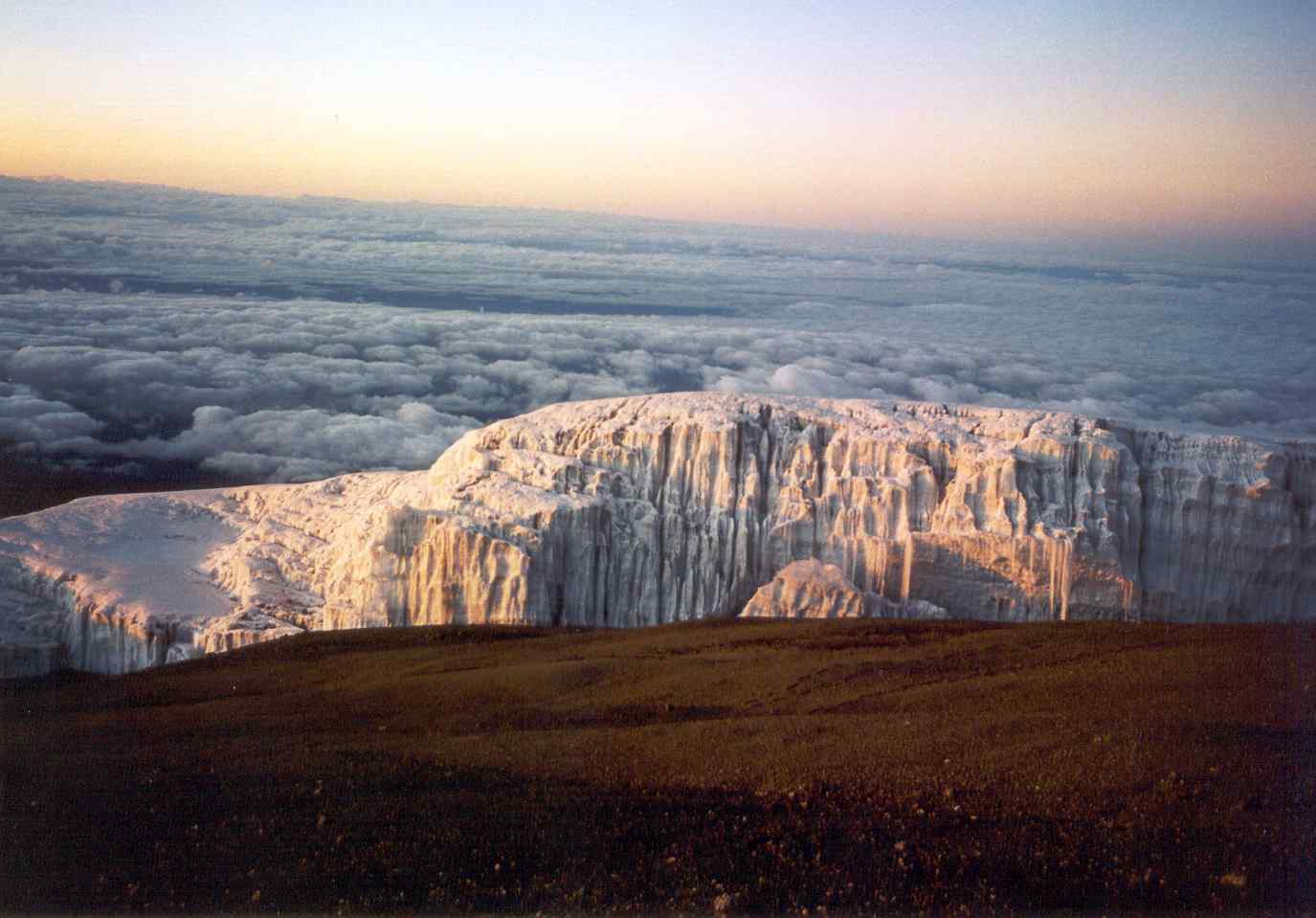
Kilimanjaro
Although we are not that satisfied about our guide Arusha, the 6 black
guys get a good tip from us. The porters and the cook worked hard
for us, and the most important thing is that they took us up there and
down again safely!
The last part of the descend ends the same way as the ascend begun:
a muddy hike through the jungle. At the end of the trail, we receive
a certificate for our achievement.
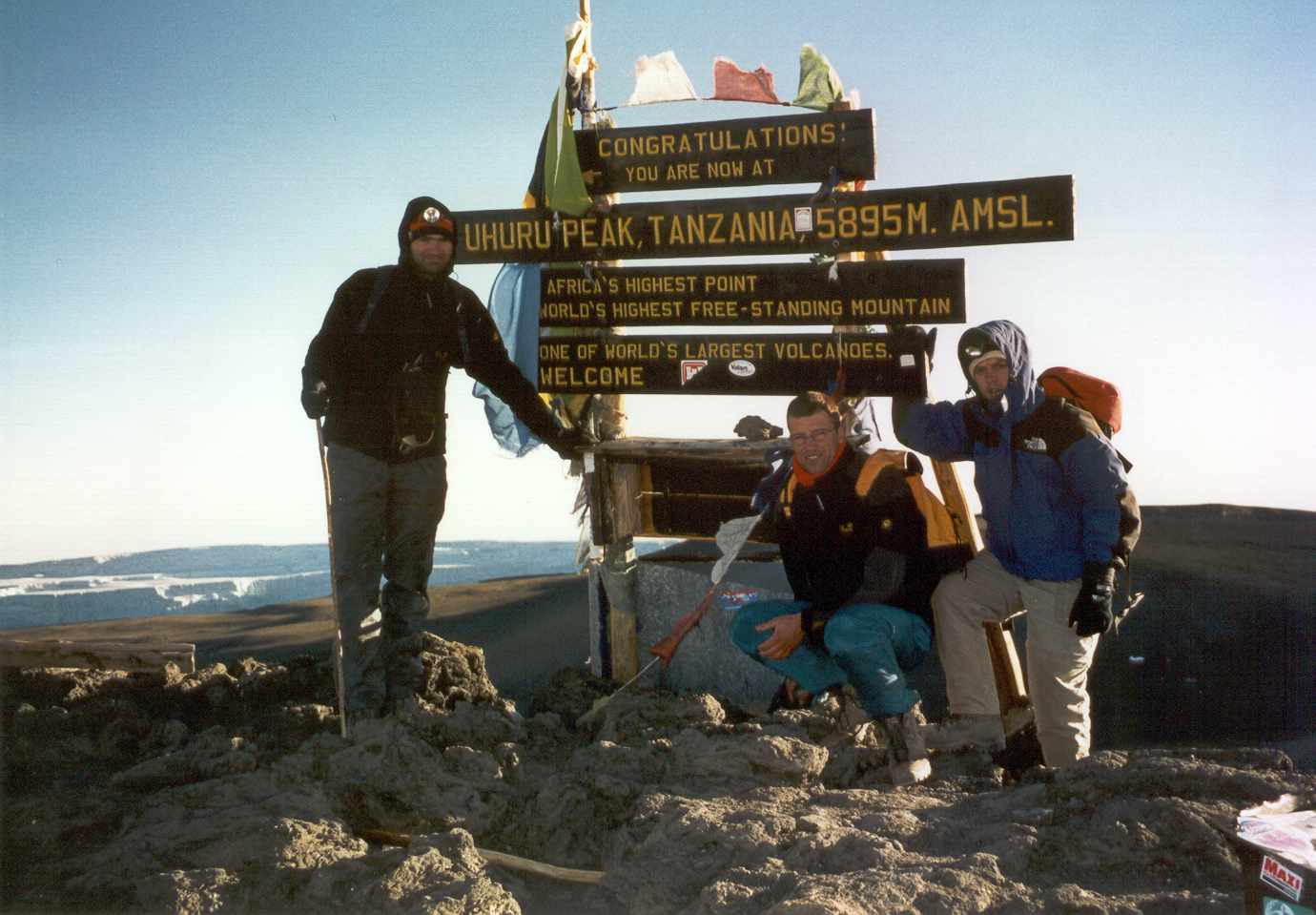
At the top
Back in Arusha I enter an internet café to read the news after being isolated from the outside world for one week. Suicide-attacks in Israel, declining stock-markets, train-disaster in Italy and threats of war from Bush towards Iraq. But there is also one good piece of news! Eight days ago, on July 2nd, my sister Ils gave birth to the little Nina. Everyone’s all right and I am a happy uncle now!
On safari
Like a team, sent by the National Geographic Television, we go on safari
to the Ngorongoro-crater and the Serengeti. Mario and Bok, the two
photographers, me, the writer, Linus, the guide and Moshi, the cook.
Our large jeep with the open roof seems to come from Jurassic Park.
A ride through the colourful Masai-villages brings us to the Panoramic
Lodge at the edge of the Lake Manyara National Park. It is a brand-new
camping lodge with a nice view on Lake Manyara and the protected reserve
that surrounds the lake. On our way, we can see some large baobab-trees.
3 years ago, we saw the related boab-trees in Australia.
A very friendly , who looks a bit like actor Morgan Freeman and
has the voice of Kofi Annan, welcomes us at the lodge.
Our very young cook Moshi cooks us a nice meal and after that, Linus
takes us to the park. The weather is very nice. The park consists
of a very dense jungle and thus we don’t expect to see much wildlife in
this green labyrinth. But we are wrong, there are lots of baboons,
vervet-monkeys, impala’s and giraffes.
A very close encounter with a herd of elephants is to follow.
Also zebra’s, wildebeest and hippo’s appear on stage and an action of a
beautiful kingfisher, that captures a fish after diving in the river, almost
makes us applaud.
After the tough climb to the top of the Kili, we now have the feeling
of holidays again. In the evening at the lodge, we have a beer and
the holiday-mood has fully returned.
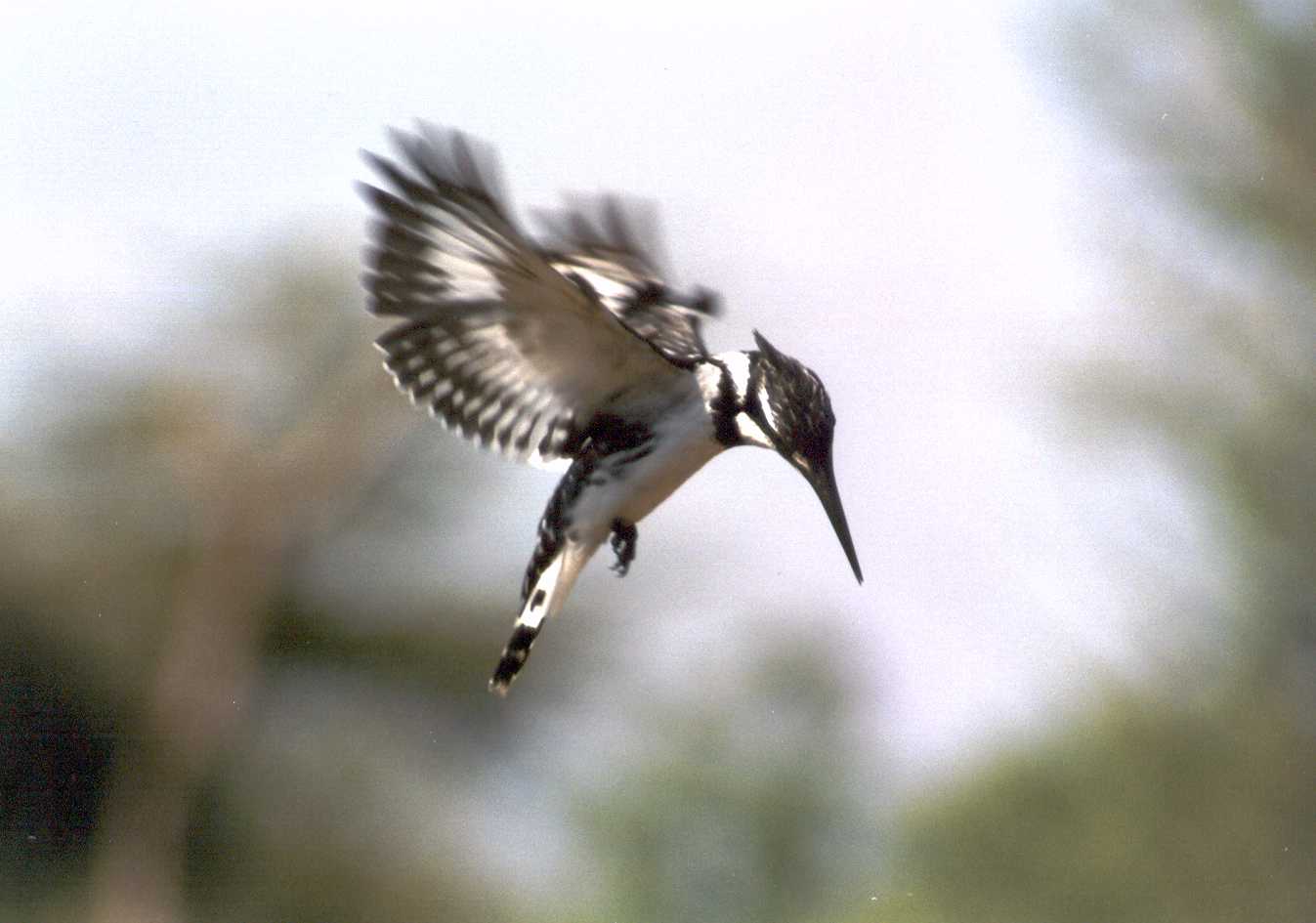
Kingfisher in action
At breakfast we hear that 2 more people will join us for the rest of
the safari. There is room for 5, so why not. Frey is from Holland
and Jason is from Hong Kong. They are both nice and will improve
the atmosphere during the safari, that much is already clear to me.
They are both doing an exchange-program in the slums of Nairobi for their
university, but now they have some holidays and that is why they join the
safari. Jason is a little crazy and Frey is somewhat more serious.
The Ngorongoro-crater has a diameter of about 20 km and is home to
lots of wild animals. There is no wire or fence here, but the steep
edge of the crater keeps the animals more or less inside the crater-wall.
When there is a big drought and the vegetation becomes scarce, some animals
temporary leave the crater, but when the climate allows it, they always
come back. The view is very nice and the animals provide the finishing
touch.
We see lions, rhino’s, elephants and ugly, but funny hippo’s.
The latter are lying lazy in the water all day long and every now and then,
they shake their tails in the water to keep their back wet. Every
5 minutes, they turn around lazy and this always rises laughter in our
jeep. When a hippo is yawning, we are laughing even more!
Today we saw 4 of the big 5 already. The elephant, the buffalo,
the rhino and the lion. Only the leopard remains to be seen, but
this animal is shy and only active at night. That is why it is difficult
to spot. Perhaps tomorrow in the Serengeti we will have some more
luck.
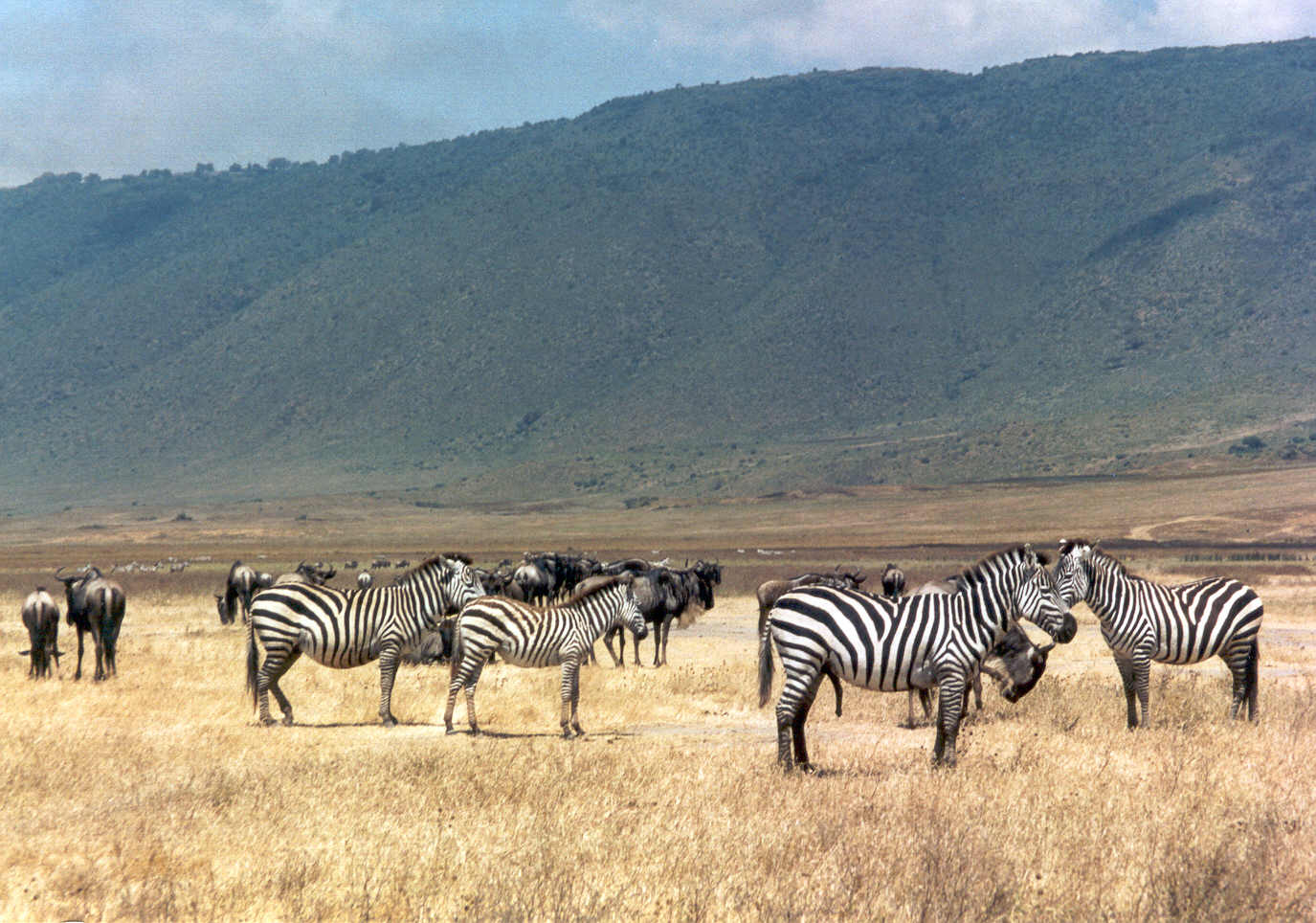
Zebra's in the Ngorongorocrater
At the dinner table, our Chinese Jason from Hong Kong goes crazy again.
“It’s time for his pill”, says Frey, the Dutch girl.
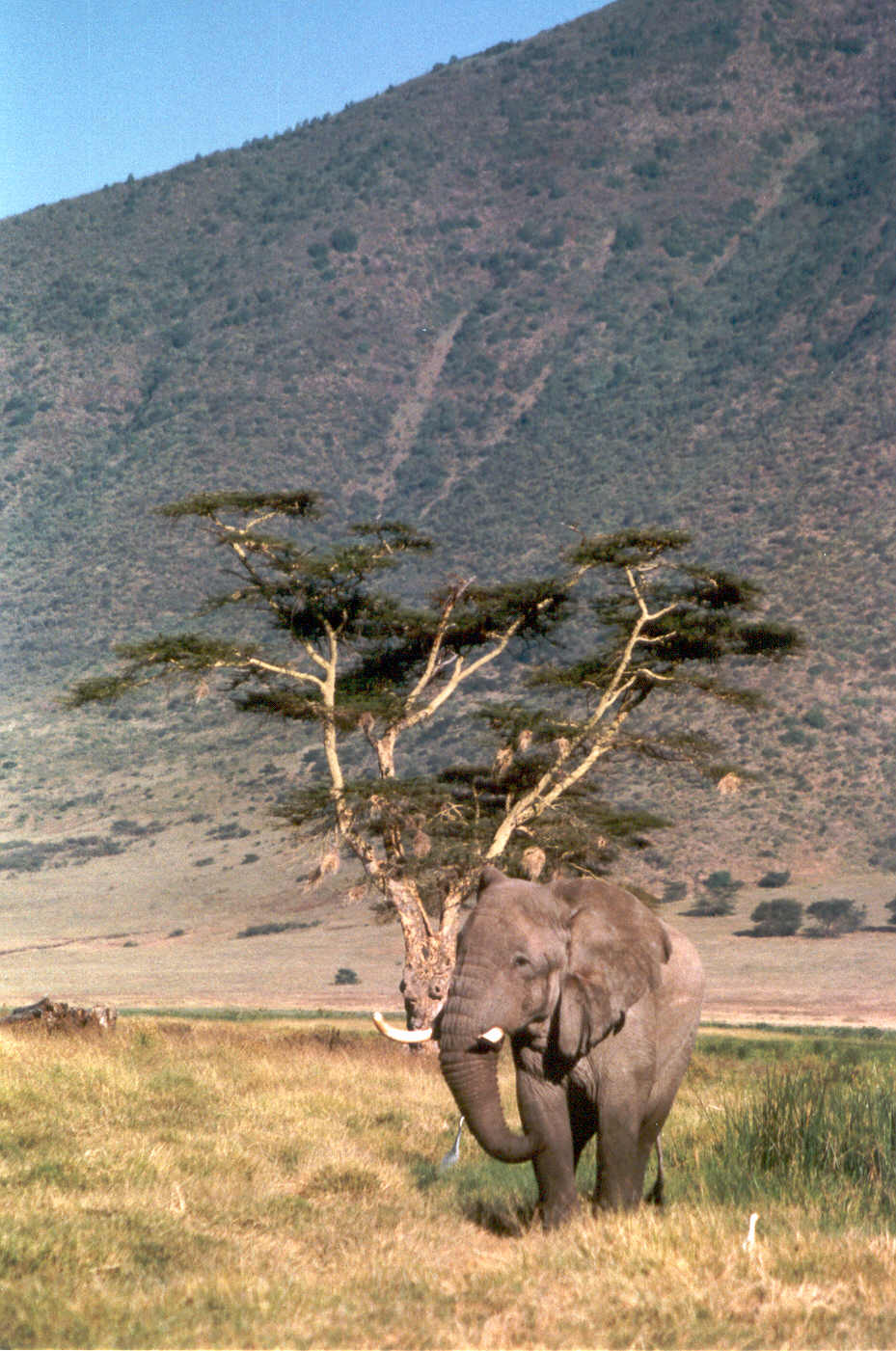
Elephant
We are on our way to the Serengeti National Park. Linus asks if
we are interested to see the Olduvai-site. It is a site where excavations
are being done, even today, to find clues about the origins of the homo-sapiens,
or modern man. For decades they were looking for the “missing link”
between the anthropoid and man. Here in Olduvai Gorge, there is a
chasm that was filled-up gradually with volcanic dust that was coming from
a close-by volcano exactly at that time of the transition between anthropoid
and man. In these sediments, fossils were found that close the gap
and the missing link was found here. Now it is generally accepted
by scientists that mankind originates in Africa. In Ethiopia and
Chad, similar fossils have been found also.
We visit the small museum at the Olduvai site and we have a view across
the valley where American researchers are at work. The cradle of
mankind is at our feet!
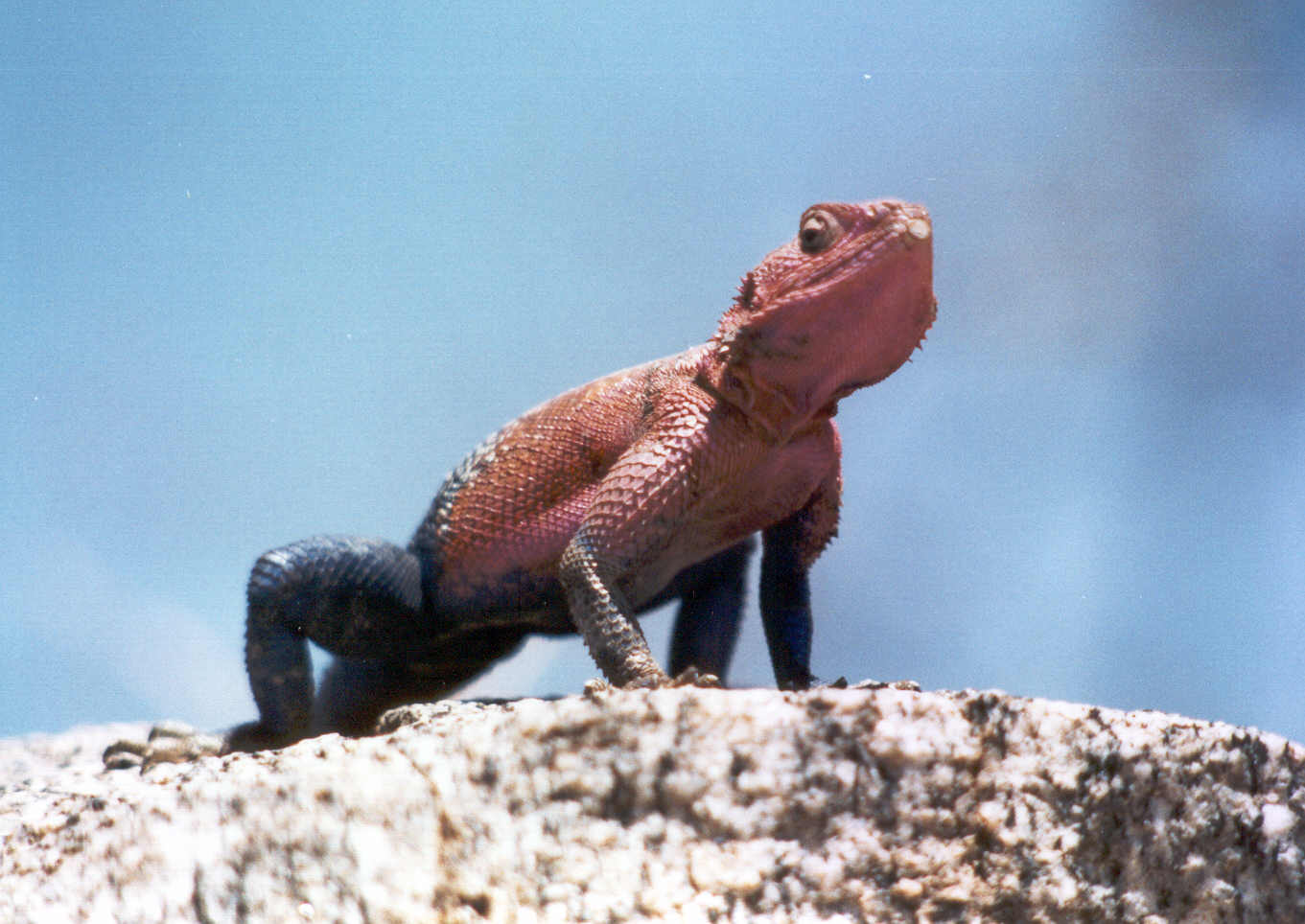
Lizard in the Serengeti
Serengeti means “endless sea” in Swahili. The yellow grass with
the typical African flat-topped acacia’s seems to be endless indeed.
It is Tanzania’s biggest national park and it is exactly half the size
of Belgium.
Linus is very alert. He shows us tens of lions and elephants
and hundreds of antelopes. Also monkeys, hippo’s, ostriches and warthogs.
We cannot find a leopard today. On his first day of safari, Jason
took 130 digital pictures already!
Our campsite is a little disappointing when compared to the lodge from
last night. Frey visits the public convenience and I inform myself
afterwards if it is OK. “It’s a hole-in-the-ground model and some
previous visitors managed to miss the hole”, says Frey. I know enough
already! There is also no hot water, but that’s OK, we are in the
bushes and we can live with that. The campground is not surrounded
by a wire, so all the wildlife can walk across here freely. When
I am sitting in my tent in the evening, I can hear the hyena’s cry.
After similar adventures in Namibia, four years ago, I took precautions
this time. A small bottle of Gordons Dry Gin makes the fear go away,
so that I can enjoy the sounds of the wild animals at night!
In the morning, four elephants walk right next to the campground.
They eat everything that’s in their way and pushing down a tree is not
a problem. Slowly they move on, while ignoring the campground.
In a dry river bed along the road, we meet a group of lions that just
caught a wildebeest. One lioness eats the dead wildebeest body while
the other lions are hiding behind the bushes.
A while further on up the road, some wildebeest are crossing a river
on their migration to the north, to Kenya. Some ten crocodiles wait
patiently in the water until a wildebeest or zebra comes closer.
Then the crocodiles will attack without mercy, but not in front of our
eyes today.
A Volkswagen-minibus with some aging Americans inside hear about the
eating lions from Linus and they want to see them also. We show them
the place where the lions are hiding, but their minibus cannot reach that
place, because the river-bed is too deep. We allow the Americans
to enter our jeep to get through the river bed. One of the two women
has the typical American body-size, it makes that we are cramped for room
in our jeep. One American old-timer doesn’t really understand what
is happening and he becomes so excited and impatient that he seems to have
in mind to walk to the lions. That should result in some interesting
pictures! At least for us.
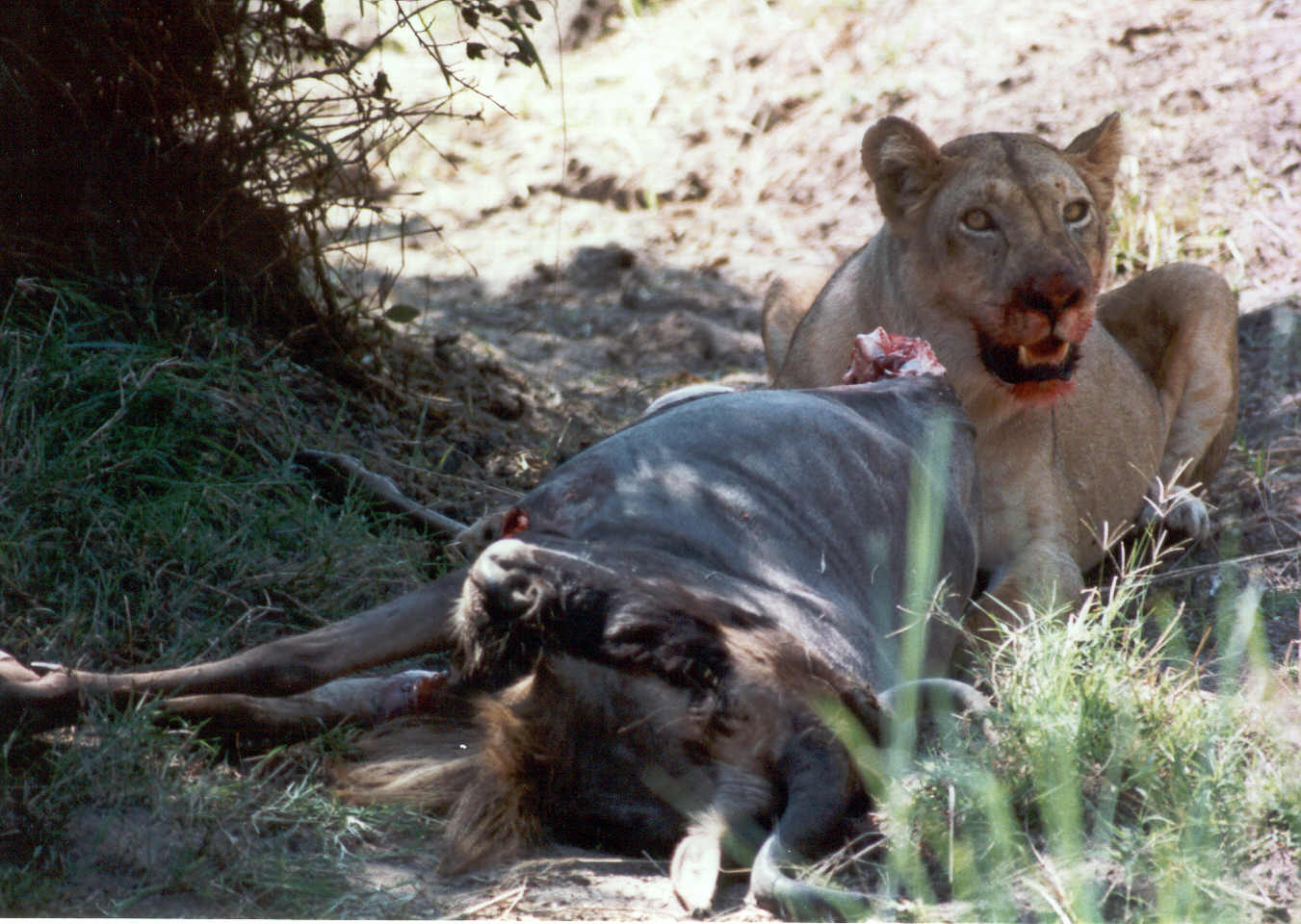
A lioness eats a wildebeest
In a sausage-tree, so-called because there grow sausage-shaped fruits
on the branches, we can see a leopard that is sleeping on a branch! We
are lucky to see this animal, because as I said earlier, they are nocturnal
animals. During the day, they often are lazy lying on a branch of
a tree.
Satisfied, because we saw all the “big five” now, we return to the
campground. On the way back, we can see a rare serval. It’s
a cat the size of an ordinary domestic cat, but it has a fur with the same
colours and pattern of a cheetah.
The night is suspenseful again! I can hear lions roar from different
directions. And the chased warthogs grunt in panic! The gin
makes me at ease again, I can enjoy the sounds of pure Africa once more!
Yesterday, Frey proposed to undertake an early-morning-safari today.
In the morning, most animals are more active because it isn’t that hot
at that time. Most of all, we want to encounter cheetahs, because
these big cats are almost the only species we haven’t seen on our safari
yet. Bok thinks he saw everything already and he remains in his tent
on the campground.
At first, we don’t see much special besides from a cool sunrise and
some hot-air-balloons flying low. They carry tourists to make an
air-safari that is presumably very beautiful, but way too expensive for
us.
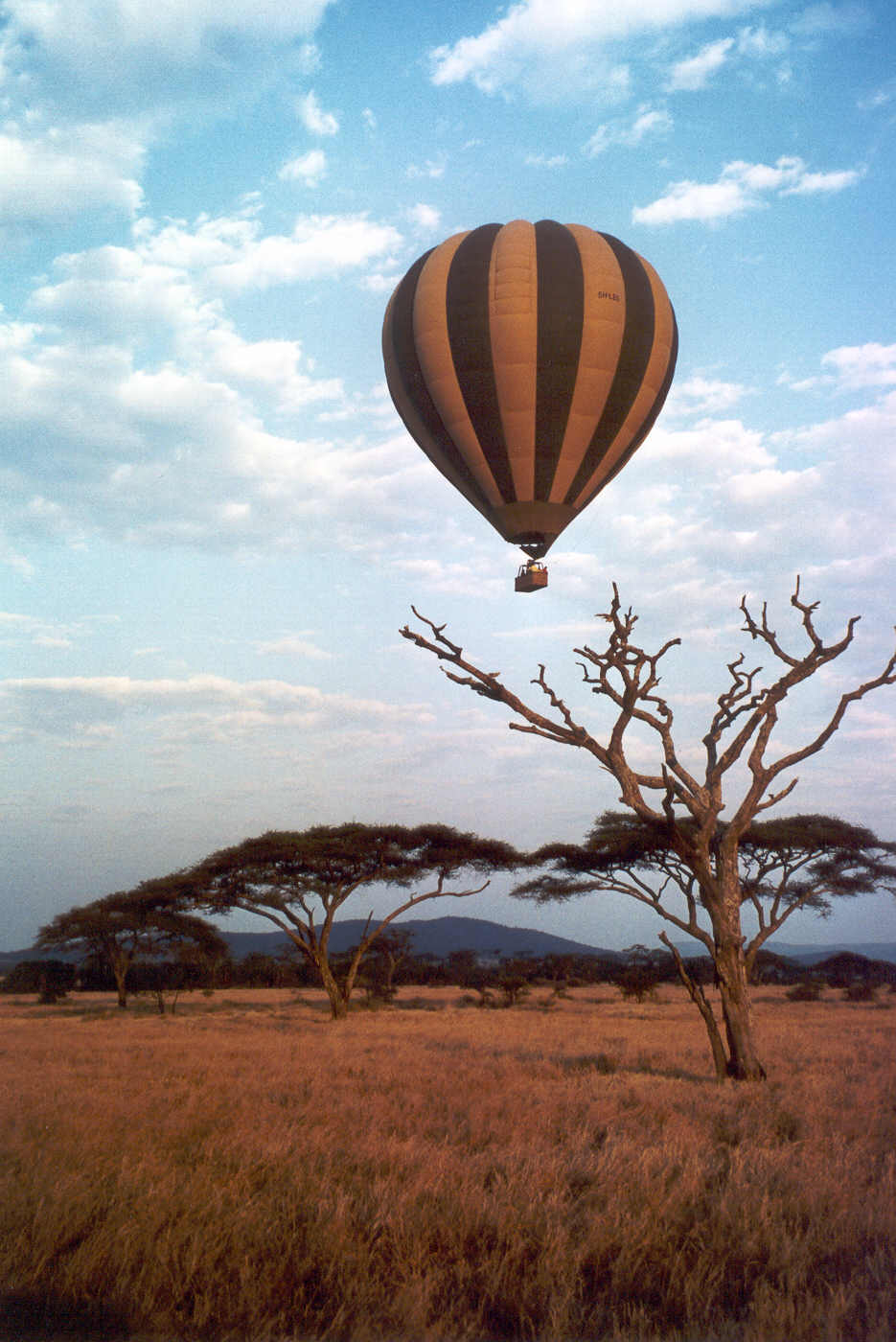
Balloon-safari
Two lionesses have a drink in a small river that crosses the road and we are in an ideal position to make cool pictures of that. There images reflect in the water. This picture will be, without any doubt, the new wallpaper of my desktop at work!
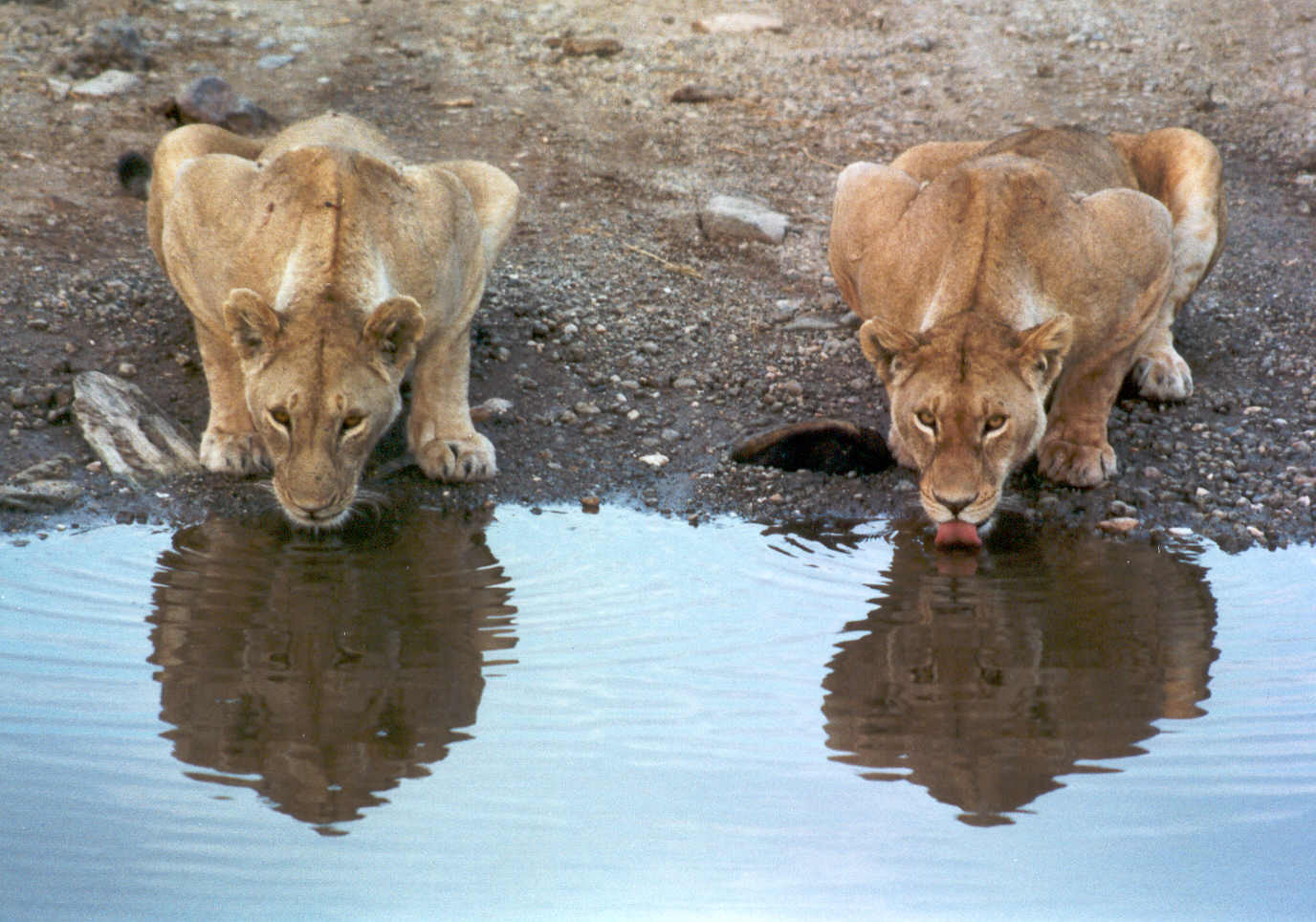
Shortly before we enter the campground again, Linus halts our vehicle…there
are two cheetahs in the grass! Mission accomplished, we saw everything.
“Too bad for Bok!”, says Frey.
After breakfast, we head back for Arusha. The trip takes almost
all-day and we have a flat tire on the way back.
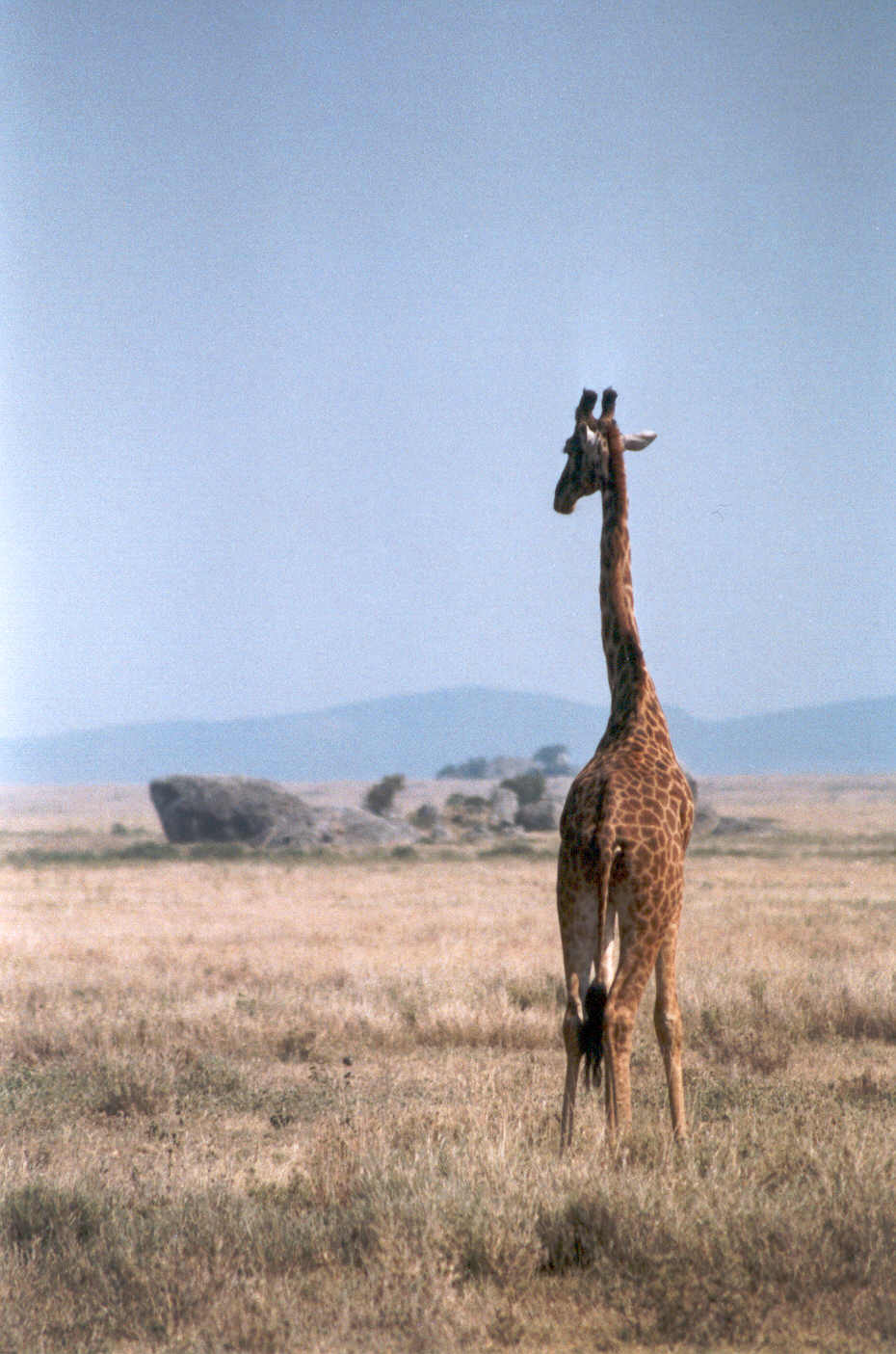
Giraffe close to the exit of the park
Back in Arusha, we have pizza with Jason and Frey in the cosy place
Pizzarusha. Our two friends will go to Zanzibar, while we will spend
some time in the Usambara Mountains in the east of Tanzania first.
Perhaps Jason and Frey will still be on Zanzibar when we arrive there,
but that looks unlikely.
Jason wants to buy the flag of Tanzania, like he also did in Kenya.
He asked all the friends he made in Kenya to sign that flag. He likes
that as a souvenir. In Tanzania, it doesn’t seem to be easy to buy
the flag, all his previous attempts failed. He regrets the fact that
he doesn’t have the flag yet, because he wanted us to sign that.
It doesn’t happen very often, but sometimes Jason is serious.
At these moments, he shows that he learned so much from his experiences
in Kenya and Tanzania and that these experiences broadened his scope and
vision so much. Jason is determined to do something about the problems
of poverty in Africa in his life, but at the same time, he realises that
he alone cannot do much about that. “I am too small” is what he says.
He doesn’t want to be rich as long as there are hungry people in the world.
If everybody in the world would be a bit more like Jason, I bet the world
would be a much better place than it is now!
We say goodbye to these two nice people.
In Arusha, today we take a day of rest. We go to the bank because
we almost run out of money. Bok is still sleepy. He wants to
exchange traveller-cheques for the amount of 200.000 shilling. With
a surprised face, he comes telling me that the bank-employee only pays
in US dollar or Tanzanian shilling. I tell Bok: “Well, we are in
Tanzania, why aren’t Tanzanian shilling good enough for you?” Bok
says: “Oops, I thought I needed Kenyan shillings, how stupid of me!”
Bok returns to the counter. Luckily for him, it’s a different
counter now. The new employee asks Bok what kind of notes he wants
and Bok answers: The smallest ones. Mario and I heard that, we are
watching the scene from a distance. “What’s he doing now!?”, I say.
The smallest notes are 500 shilling and Bok realises his second stupidity.
“He messes up everything!”, says Mario. Bok clarifies to the bank-employee
that this large amount of paper (400 notes!) will never fit into his wallet.
In the end, he gets larger notes. The nicest scenes often appear
in the least-expected places!
Usambara Mountains
Lushoto is a quiet village in the Usambara Mountains in the east of
Tanzania. We meet a couple from Kortrijk and with them, we plan a
day-trip for tomorrow to a mountain-top in the neighbourhood.
In the Mandarine Hotel, we seem to be the only 3 guests. When
we have dinner in the hotel, 20 more plates are on the tables. Long
after we finished our dinner, still nobody shows up and we assume that
these plates are put there only to give us the impression that many people
have dinner here. Late in the evening, 20 hungry Norwegians show
up. No more quietness now!

Fruitsale in the Usambara Mountains
With our guide Abu and Linda and Frank from Kortrijk, we climb to the
Rolling Rock. Linda has some problems with that climb. Three
days before departure to Tanzania, she had a foot-operation and now she
cannot follow us. Frank stays behind with her, when Abu takes us
to the top of the mountain.
We are off the beaten track and the local people are more friendly
than in for instance Arusha. We eat passion fruits and sugarcane
that grows next to the road. On the coffee-plants, there are several
chameleons. We can hold them, because they never bite according to
Abu. But the animals do make a threatening sound!
When we go down again, we meet Linda and Frank again in the village
where we had left them. They seem to know all the villagers already.
Fifteen black people surround them, all laughing and acting crazy.
In the evening we have dinner in the Sun Hotel. All customers
are white, there are 15 of them and by coincidence, all of them are Belgians!
After dinner, we say goodbye to Linda and Frank.
We charter a vehicle to go to the village of Mtae, 65 kilometres to
the northeast from Lushoto. We have to drive slowly, because the
dirt-road is full of holes. In the village of Mlalo, we make a stop.
Many farmers cultivate the land here, they grow vegetables in the area
around Mlalo.
Tanzania is just like so many other African countries, very poor.
In recent years, many of the crop-harvests have failed due to the continuous
drought. After September 11th, tourism also declined and the income
of the country has dropped drastically. The entire economy of the
nation is in a downward spiral and, despite the nice words of president
Mkapa, there is no progress in sight for the near future.
In a restaurant in Mlalo, there is an old poster against the wall with
the slogan: “The great thing in this world is that it doesn’t matter where
we are now. The important thing is in which direction we are going.”
The poster dates from a time in the past when it all went better.
Now the colours of the poster have faded, together with the optimism in
the slogan…
The road literally stops in Mtae. The village is located on a
rock, close to an abyss. On the streets, the children approach us.
Some are afraid, some are not. When we walk through a primary school,
we are the main attraction for the children.

Children in Mtae
It is an area with mountains and because a lot of farming is done here,
the ground is subject to erosion. That is why different projects,
funded by especially German and Dutch money, are set-up here to do re-foresting.
Different from our regions, the layer of fertile soil is very thin in the
tropics. Only tree-roots prevent the soil from flowing away after
heavy rainfall. If the trees are cut-down to do farming, the rain
will wash-away all the fertile soil, especially in mountain-areas like
these. Mud-flows are created and naked rock is all that remains.
And consequently, farming comes to an end also. That is why it is
so important to prevent erosion and re-foresting is the best way to do
so.
In our hotel in Lushoto, we really are the only visitors tonight.
The boss tells us that he felt September 11th very hard to his income this
year. CNN is on and they talk about the threat of war from America
towards Iraq and the hotel manager has a bad feeling about that.
Will even less tourists come to his hotel?
When he asks us where our women are, I reply: ”You know the Bob Marley-song,
No woman, no cry?”. He laughs very loud after that.
Dar Es Salaam
We don’t like Dar. When we get off the bus, we don’t know exactly where we are, so the taxi-driver can ask us any price he wants. Our hotel is owned by a Muslim, so it is alcohol-free. In the city there is not much to see and tiresome touts follow us all the time. Many restaurants and bars from the Lonely Planet have gone or moved. The Hard Rock-café is closed due to yearly holidays, and that in the middle of height-season! There is however one place we do like, the new Florida Pub. The food is tasty and cheap and there is beer. We almost spend the whole day in this bar, which is our only positive experience in Dar Es Salaam.
Zanzibar
Zanzibar is an island that belongs to Tanzania, but it has however some
semi-autonomy. The ferry-trip from the mainland takes about two hours
and at the border-control, we receive a stamp from Zanzibar in our passports.
After we passed the border, we are followed by 9(!) black people that all
want to accompany us to a hotel suggested by them to collect a commission-fee
from that hotel. They are fighting and shouting at each other, because
they all want to take us to their place. They want to get rid of
each other. It is their way to survive. Only the porter of
our backpacks gets a tip from us, he is the only one that actually did
something for us. After passing two fully-booked hotels, we arrive
at the Haven Guesthouse and here is some room for us. The hotel manager
laughs at the fighting black people and we are happy we got rid of them.
Besides from this incident, Zanzibar seems to be a paradise at first sight.
Haven Guesthouse is located in the heart of Stonetown, the capital
of Zanzibar. The centre is a labyrinth of narrow alley’s between
white-chalked houses. There are no cars within the centre, the alley’s
are too narrow for them.
Zanzibar is an island of spices. The land that wasn’t privatised,
was divided by the government among the poor people and now they grow ginger,
cinnamon, clove, pepper, coffee, coconut, banana etcetera. They can
live from that, but they won’t become rich of it.
We take the popular spice-tour and we can taste all the spices, which
put our mouth on fire. They say that 80% of all the clove-production
in the world comes from Zanzibar. The remaining 20% comes mainly
from Asia.
Zanzibar is also the place of birth of the late Freddie Mercury, the
singer from the British pop-group Queen. He died of AIDS more than
ten years ago.
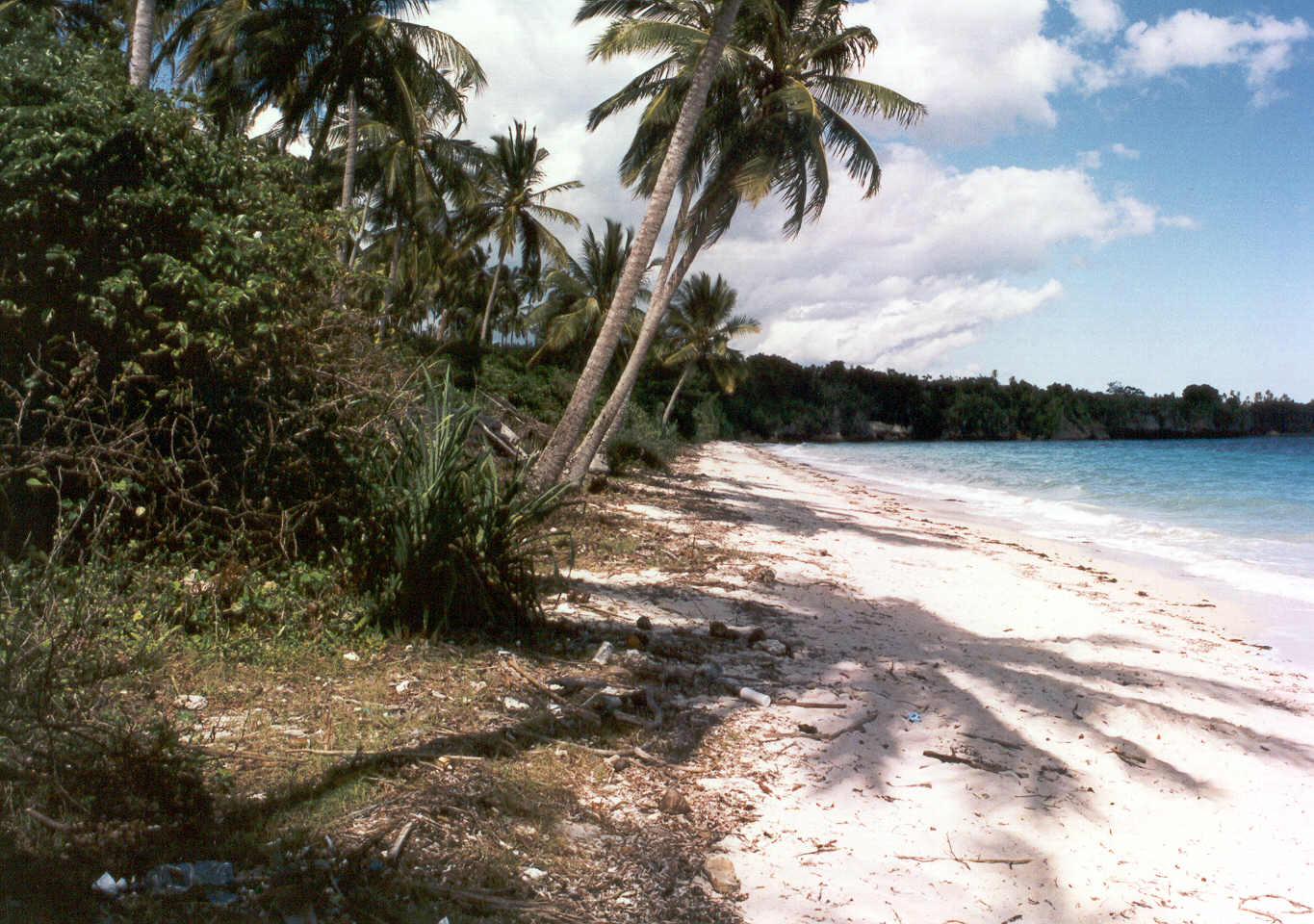
Bounty-beach on Zanzibar
Through e-mail, I learnt that our friends Jason and Frey from the safari-adventure
in the Serengeti are still in Zanzibar. We can meet them today if
we stay in Stonetown. They return from the northern beaches and take
the boat back to mainland Africa today.
Jason is happy to see us again. He managed to buy the Tanzanian
flag and now we can still sign it. It was a difficult task to find
the flag. He could eventually buy it in a governmental building 3
km outside of Dar Es Salaam. He was afraid, because that building
looked like a jail and he was interrogated about what he intended to do
with the flag. After that, Jason had to listen to the story about
the meaning of the flag. The green colour stands for the plants of
Tanzania, the yellow for the minerals, the black for the people and the
blue for the water.
On the roof of the Africa House Hotel, we have lunch, sign Jason’s
flag and say goodbye.
In the evening, we leave a bar at 11.30 PM and I am approached by a
black guy. “I want to speak the truth”, he says to me. “I am
a tout and survive from the tips I get from hotel-and restaurant-owners
when I bring tourists to them. But today I had bad luck and couldn’t
earn any money. Now I am hungry. Could you please give me something,
it doesn’t have to be money. A plate of food from the fish-market?”
I shudder to think of a man having to survive this way and I give him what
he asked me for.
With a wooden boat full of cockroaches, we go to Changuu Island, better
known as Prison Island. It is a very tiny, but green island 30 minutes
outside Stonetown. In the past, it was used by the Arabs to fatten
the Negro-slaves that were too thin, in order to make more money out of
them. The ruins of the prisons are still here, the slaves are all
sold many years ago…
Prison Island is also haven to the last big remaining colony of Aldabra-tortoises.
They originate from the Seychelles, but have become extinct there already.
The cause: man.
The adult animals are 1 meter in length, 300 kg heavy and become 100
years of age. It is the only species of 8 giant tortoise-species
that inhabited the islands of the Indian Ocean that is not extinct yet.
The Aldabra-tortoise is the second biggest species, only the Galapagos-tortoise
in Ecuador is even bigger. Besides Prison Island, there is a small
population on Mauritius and perhaps some animals in a zoo somewhere across
the globe. The tortoises on Prison Island are heavily guarded behind
an electrical wire. Before they installed this wire, many animals
were stolen. In 1996, there were only 7 tortoises left on the island,
but now the number has increased to approximately 200.
There are signs everywhere with the text: “Do not sit on the tortoises
please. Thank you!”
I can imagine that some children want to have a ride on the back of
a tortoise.
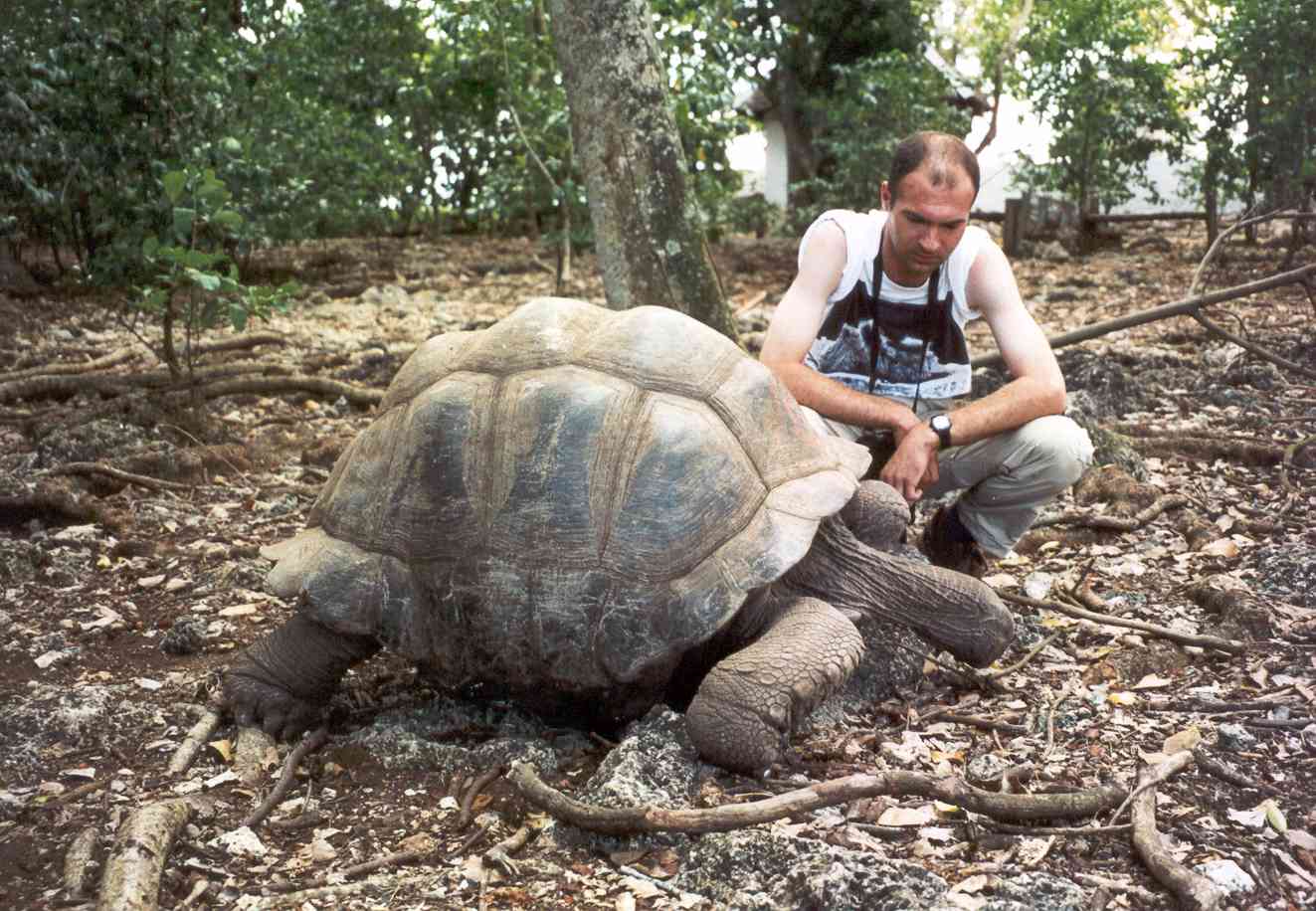
Aldabra tortoise
Back in Stonetown, Mario and I think that our hair has become too long
and we go to a hairdresser. Once our hair is cut, we leave the place
and the hairdresser escorts us back to our guesthouse. He is worried
that we would get lost in the labyrinths of Stonetown.
At night, we eat at the fish-market in Stonetown. The food is
cheap, but tasty and fresh. At one of the stands, I order a tuna
fish on a needle with vegetables and fries and sit on a bench to eat.
The last hunk of fish was hanging next to the barbecue, I suppose because
it is still raw and I leave that on my plate. A young black boy sits
next to me and he taps on my shoulder. “Mister, may I have the fish
please?” I say yes and like a hungry animal, the boy takes the fish from
my plate. Fully convinced now that there is hunger on the island,
I order a second plate and eat only a little from that and put it on a
table. I turn my back and a few seconds later, I look over my shoulder.
The plate has already vanished in the night…
Mario picks-up his diving material in the DHL-office and that bag that
was sent from Belgium did arrive here. Today we stay in Stonetown
again and we meet four Belgian people from Louvain. One of them has
a high fever and they wisely decide to go see a medical doctor. Turns
out he’s got malaria and instantly gets mefloquin-treatment, a tough treatment,
they say. It is a bit terrifying to us also, because now we realise
that malaria is a real threat here. Nowadays, malaria is easier to
treat thanks to new and better medication, it is now possible to even cure
that completely. But still death rate from malaria is at 1%.
The main reason of this is that many victims wait too long to go to a doctor
and simply die of too high fever.
Two of the people from Louvain take us to the Via Via on Zanzibar.
There is a female Belgian owner at that place. She had malaria also
for several times already.
I drink a Tanzanian beer in a Belgian Jupiler-glass. The beer
goes in a little too smoothly. In the same way as I reached the top
of the Kilimanjaro, I now leave the Via Via in Zanzibar.
In the north of Zanzibar, there are some nice “Bounty-beaches”.
We go to village of Nungwi and it rains all day. Although it is not
too cold, the sea doesn’t invite us much to swim. But Nungwi is a
tourist-spot by the book, so there is enough to see and do to spend the
day.
A white female, who apparently just arrived on Zanzibar, orders a Cola-light
in a bar. “I am sorry, but we don’t have that”, the waiter replies.
As if in a hungry continent like Africa, there would be a need for such
a poor-in-calorie diet drink!
In the evening the sun appears. We are getting a nice sunset
after all. Tens of sailing-boats leave the shore, they will fish
at night. The small sailing-boats are called dhow’s here. Musing
from the beach while the sun is setting and the boats are leaving, I imagine
what would happen to the poor fishermen if their dhow’s would be destined
to have the same fate as that other Dow we all now from the US and which
has fallen to enormous depths this summer…
Nungwi awakes, different than yesterday, in a burning sun. We
walk along the beach to the “aquarium”. Here they hold turtles and
fish. The natural lake in which the animals are kept is connected
to the sea. The water is salty and goes up and down, together with
the tides. The turtles are even doing better than the tortoises on
Prison Island. They become 120 years of age and grow 1.5 meters in
length! These animals are also highly endangered to extinction.
They are protected animals, but their meat is a delicacy. In this
lake, the young turtles are kept until they are old enough to be released
into open sea. It is nice to notice that in Africa too, they start
realising they have to protect their native species and prevent them from
becoming extinct. Perhaps this is only a drop of water on a hot plate,
because there will always be hunters in a continent with so much hunger.
But it is a start anyway…
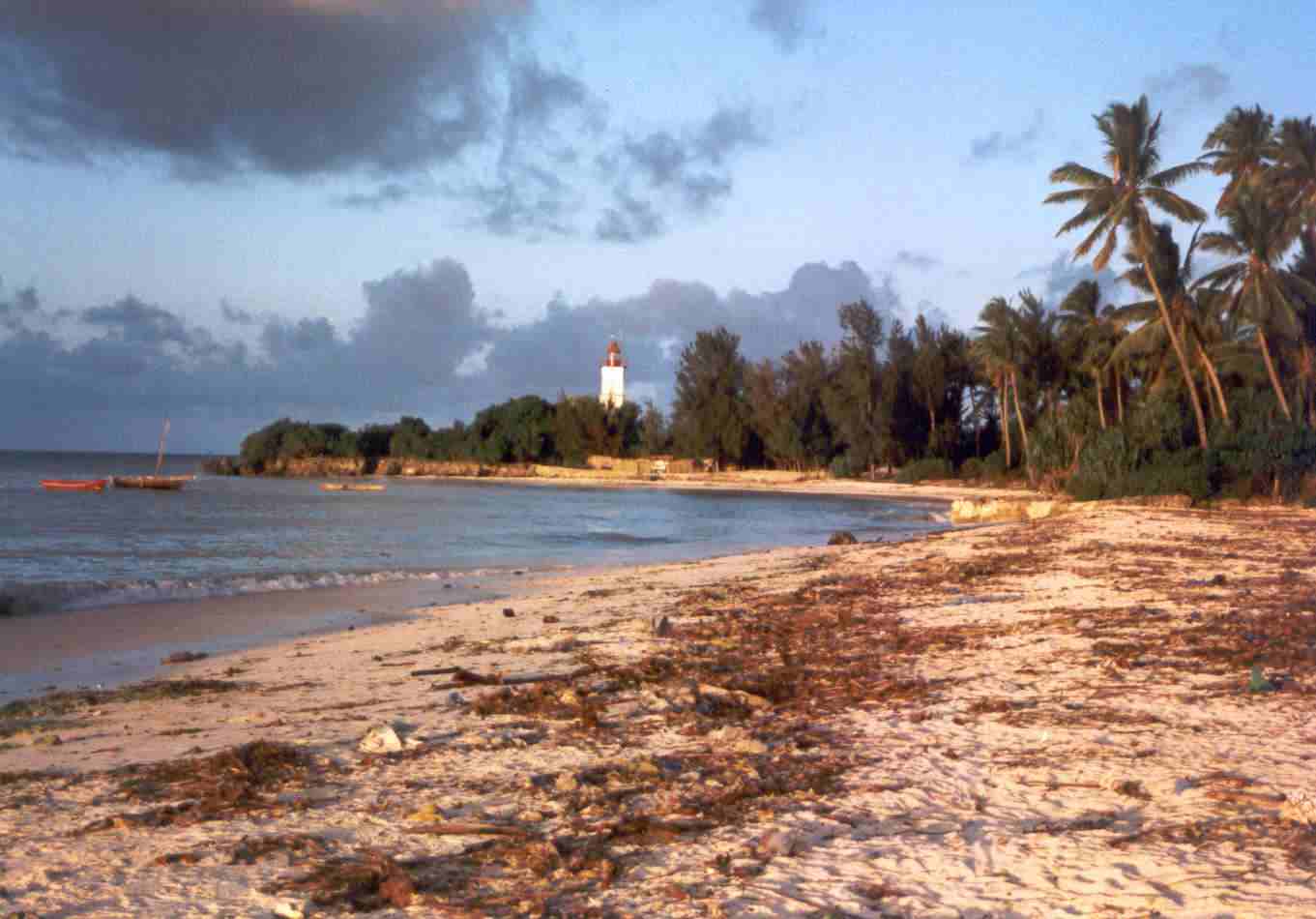
Nungwi in the evening
We're getting another beautiful sunset tonight. Bok and Mario
are on a photo-hunt again, while I enjoy the spectacle on my own on a rock
near the beach. Underneath me, the waves are smashing. There
is a plastic bottle, dancing lonely on the waves while the sun slowly reaches
the horizon. Suddenly a second plastic bottle rises from the sea.
Through an amazing coincidence, the two bottles touch each other.
They float together for a few moments, and then each go their own way again
in the endless sea. And I think about Jason and Frey, how we met
them through an amazing coincidence and how we had a good but short time
together in the Serengeti, the endless sea. And how we parted, each
going our own way and probably never meet again...
Bok and I leave Mario behind in the morning. Our travelling has
come to an end, but Mario stays one more week to dive here.
On the way back to Stonetown, my mind wonders if Zanzibar really is
paradise like it is always presented.
Surely not for everybody. The locals are poor and some of them
are hungry and for many of them, there is the daily struggle to somehow
survive. And for the rich visitor? It is a place that invites
us to live through beautiful moments. Sharing food with the hungry
people, musing at sunset with dancing plastic bottles. These moments
make paradise, I guess, not really the location only.
Our way back home is divided into 7 steps with 5 different modes of
transportation. First a minivan to Stonetown, then a boat to mainland
Africa, after that a taxi to the airport of Dar, then a flight to Amsterdam,
a train to Berchem, another train to Heist, where dad gives us a ride to
home in his new Citroën. And then, there is another moment in
paradise. For the first time in my life, I see the 4 weeks old little
Nina, together with her mom, dad, grandma and grandpa. And now I
know for sure, paradise is not a place, it’s a moment, no matter where…
Yves Van Roosbroeck
Hallaar, August 2002